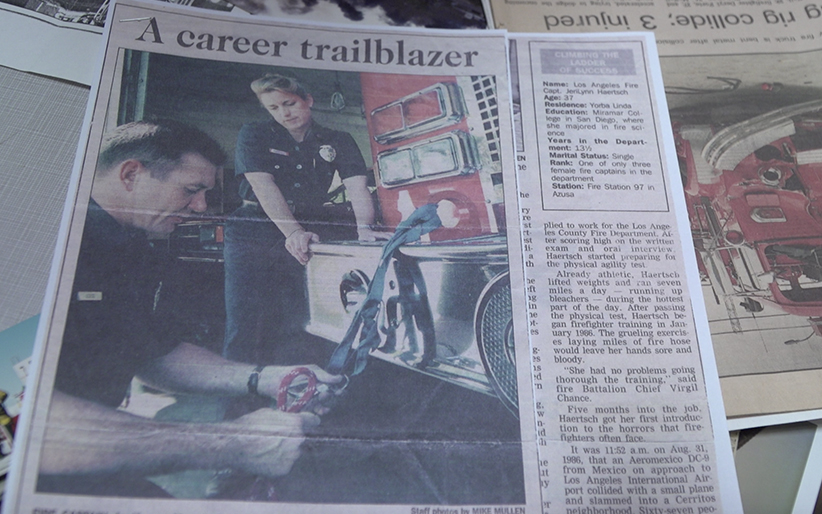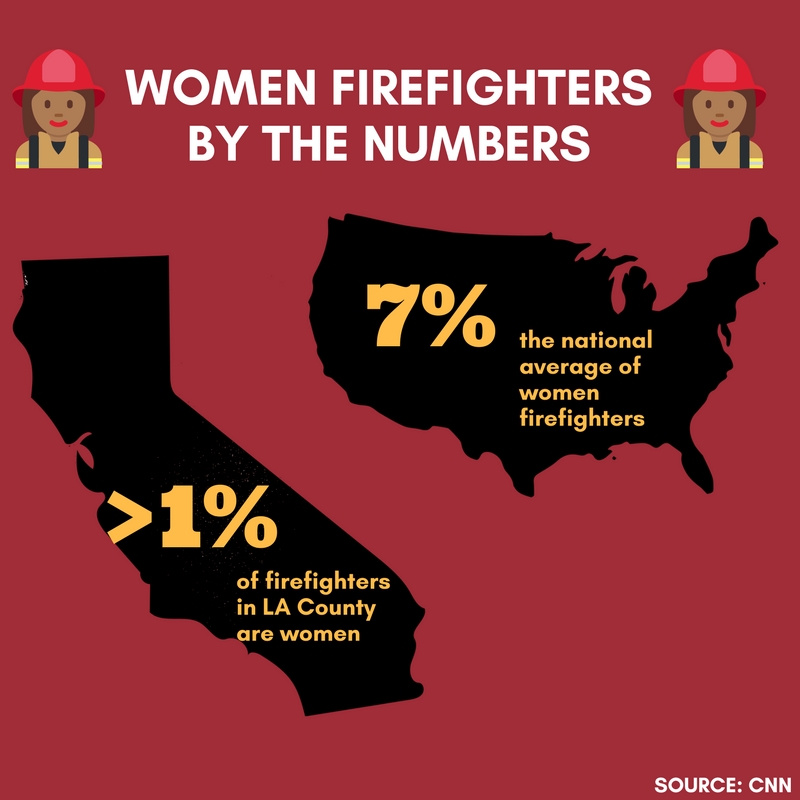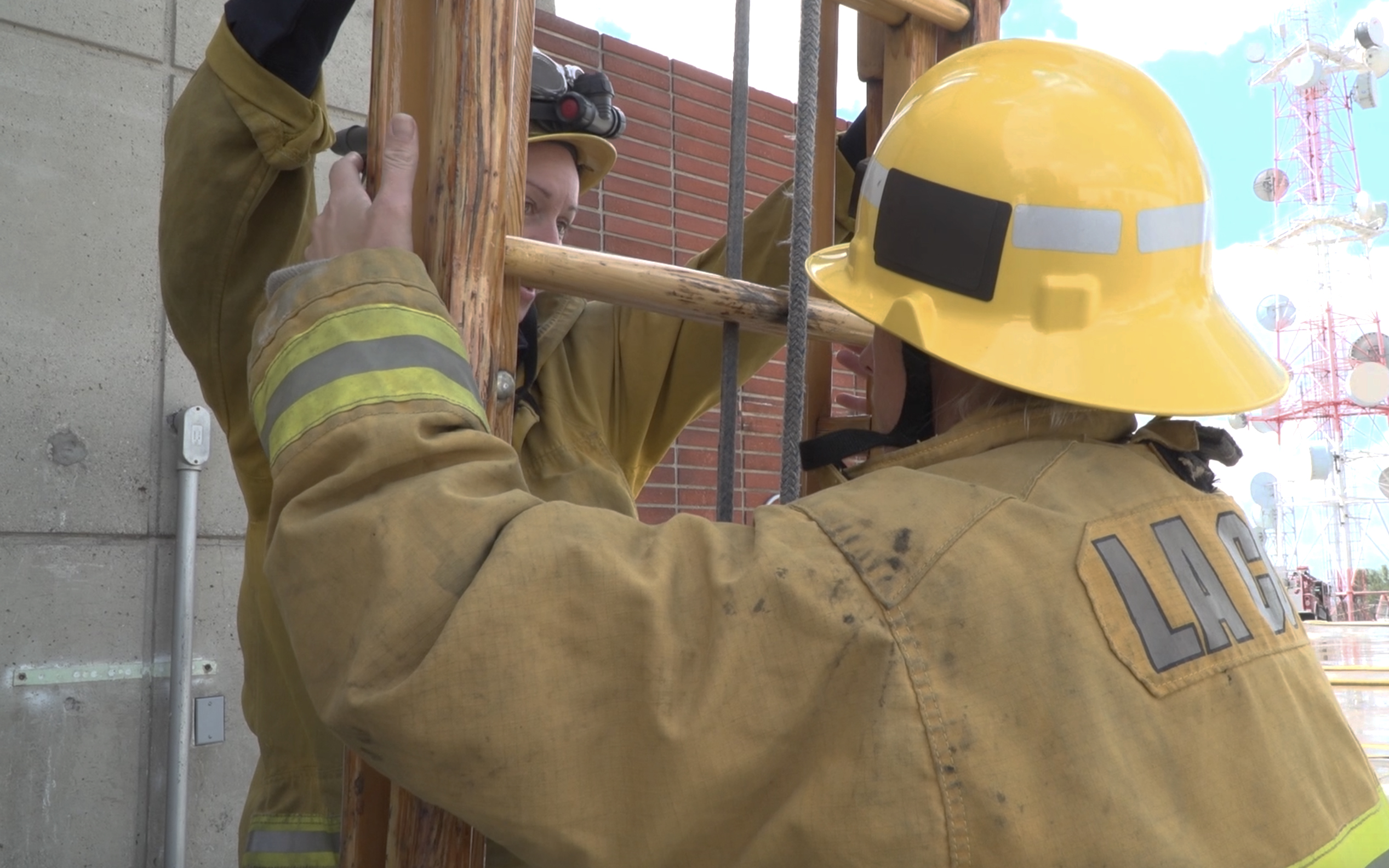Fighting Fires while breaking barriers
When Cindy Barbee showed up at the Tower on her first day of the Los Angeles County Fire Department Academy in 1983, she was one of a kind.
“It was 100 percent male except for myself,” she said.
Barbee grew up believing she could compete with the boys. She remembers wanting to win the prized teddy bear so badly at a family picnic, that she got up after falling in a relay race and bolted in front of all the racers, including the boys. Her victory that day unleashed a competitive side that would stick with her for the rest of her life.
She again proved her athletic ability playing college softball at UCLA, and eventually decided that firefighting was the career she wanted to pursue. But despite her qualifications, she still received pushback for her chosen career.
Having previously worked in the fire service across California, Barbee decided to test her luck with what she considered to be one of the top departments in the nation: LA County.

(Barbee made headlines after joining the LA County Fire Department)
But her gender alone was enough to raise eyebrows when she first stepped on to the job. In the academy, and even once she was placed at a station, her abilities were doubted. She found herself in a position of having to prove herself; many of her male co-workers didn’t believe she should be in the department at all and wives of male firefighters even questioned her ability to save their husbands’ lives.
Despite being in the position of having to prove herself, she went a step further to make positive change within the department for the next generation of female firefighters.
With the second female firefighter in LA County, JeriLynn Scavarda who came on to the department in 1986, Barbee helped to create a female counterpart to the traditional male grooming standards.
While Scavarda says she showed up to orientation in a pink fuzzy sweater and floral pants, she too was required to get the standard men’s military haircut. Both women say they were often confused for young men while on the job.

(Scavarda graduates from LA County's 70th recruit class in 1986)
Scavarda said that she was asked to go to conferences to promote being a female firefighter, yet she didn’t feel like the department wanted her to look feminine. That didn’t sit right with her.
“I was always of the mindset that I want to be a firefighter, but that doesn’t mean I want to be a guy,” Scavarda said.
Together, Barbee and Scavarda worked to establish a set of grooming standards for women that included being able to grow out their hair as long as it was tightly tied back on the job, and being able to wear small stud earrings.
They also advocated for women’s cuts of turnout coats, the protective yellow jacket that firefighters wear, and other equipment. But one of the biggest challenges they said was trying to get to the bathroom, which was often just one toilet in the middle of a locker room. Many of the stations have since been remodeled to add privacy to the bathrooms, which is both beneficial to men and women in the fire service.
(
Today, Barbee is receiving credit for the change she brought to the department. Earlier this year, she was honored at LA County Fire Department’s inaugural ARISE summit with the first-ever Trailblazer Award.
Now, 35 years after Barbee first joined the department, a new trailblazer is emerging. Firefighter Erin Regan, who presented Barbee with the Trailblazer Award, has been in the Los Angeles County Fire Department for 10 years and is trying to recruit women who view firefighting as a possible career choice.
(Erin Regan pays tribute to Cindy Barbee's career at the ARISE summit on March 29, 2018)
Today, there are approximately 45 female firefighters out of 4,000 across the department. The national average of female firefighters sits around 7 percent, according to a 2016 article from CNN Money. In LA County, the number is less than 1 percent.
“I had no idea that women did it. I could’ve thought I was the first one,” Regan said. “You’re sure that there’s some out there, but you never see it.”
Regan, a firefighter paramedic with LA County, decided to apply for the job after some of her uncles mentioned to her that she’d be a good fit for the job. Similarly to Barbee, Regan also has an athletic and competitive background as a soccer player.
Regan said being a female firefighter is like being a unicorn. And as might be expected, not many people know how to react when they see her or her female colleagues.

“With numbers as low as we’ve had in the past leading up to now, it still just sets us apart,” she said, recognizing that those low numbers can be foreboding for women who are considering becoming firefighters.
Being the “other” in the fire department comes with harassment for some of the women. LA County Firefighter Catherine Whitby says she’s been harassed on the job in various ways from her colleagues misinterpreting her strength and ability to rumors being spread about her having inappropriate relations with colleagues.
(Firefighter Catherine Whitby talks about harassment on the job)
“I’ve had pictures of me posted around the fire station in not appropriate work attire that someone researched and found on the internet somewhere. I’ve faced stories about erroneous things that have occurred,” Whitby gave as examples of some of the harassment she’s had to deal with since being in the fire service.
“I don’t think the men face those challenges,” she continued.
Veronie Steele-Small, a battalion chief with the LA County Fire Department and the second African-American woman in the department, said that most of the stereotypes and harassment she’s faced had to do with gender.
Steele-Small said that women coming on to the department disrupted the “boyhood” that had always been there. In her opinion, male firefighters blame things like now having to sleep in their shorts on women being around and not on having to be ready to go at a moment’s notice.

(Veronie Steele-Small at the Women's Fire Prep Academy on March 31st, 2018)
Challenges on the job also extend into motherhood. When firefighter-paramedic Kimberly Reyes joined the department almost 18 years ago, there was no program for maternity leave.
“The rule was as soon as you told them you were pregnant, you go off [the job],” she said about the former policy. However, Reyes says there are more opportunities now to work in an office job during pregnancy so that expecting mothers don’t have to worry about the health of their baby.
Steele-Small is the mother of a two-and-a-half-year-old son. For her the challenging part of being a mom on the job is when she has to be away from her son for long periods of time, like when the Thomas Fire was burning late last year.
“I mean we just had to be there because it was a disaster. We worked two, three, four, five days in a row,” she said about the time she spent fighting the Thomas Fire. “ My husband can deal with it, but for my son it’s a little difficult. Thank God for FaceTime.”
Through her own experience of not knowing any female firefighter herself before joining the fire service, Regan realized that there is a lack of exposure to this particular career for girls and women. So, with a few of her colleagues, she decided to start the Girls Fire Camp and the Women’s Fire Prep Academy.
Inside The Women's Fire Prep Academy
After the success of the Girls Fire Camp, a camp for girls age 14-19, Regan and some of her colleagues decided to start the Women’s Fire Prep Academy in 2016. While the girls camp was designed more as a sports camp to expose young girls to the fire service, the Women’s Fire Prep Academy (WFPA) is designed to recruit women into the fire service.
Women interested in becoming firefighters can apply to the WFPA. Regan said the application process includes attending an initial session and passing a fitness test. This year, about 70 women with the highest fitness test scores were accepted into the prep academy.
In three years, the academy has grown significantly. When the program first started, Regan said she and her colleagues lacked sufficient support from the county fire department.
“The first one that we offered, we accepted about 48 females into it, but we had over 130 apply and show up on the first day,” Regan said. “So we had to cut it down based on certain criteria… just because we couldn’t accommodate that many people. “
But as the WFPA gained momentum and with an increasing push for women in the fire department, the county’s support of the program reached an all-time high this year.
This year it was held at the Tower at the LA County Fire headquarters and was given more access to the county equipment the main academies use to train new firefighters. While the first year’s staff was made up of the core group of women who founded the WFPA, this year the instructors included women and men from across the county.

(A male firefighter preps recruits for a fitness test)
Regan says having male advocates for the program is one of the keys to its success. “Any men that recognize that it’s valuable to have a diverse work force or that it’s valuable to have females around, those are the people that will spread a positive message about what we’re doing.”
Other fire departments have followed in LA County’s footsteps by starting their own versions of the Girls Fire Camp. However, earlier this year San Diego’s Girls Empowerment Camp raised some questions about gender discrimination and was canceled after an attorney claimed his client’s son was “deterred” from going to the camp “because boys were not invited to attend.”
However, San Diego Mayor Kevin Faulconer ended up reinstating the camp, which was attended by 71 girls and one boy, according to the San Diego Union-Tribune.
Claims like these make Regan shake her head. “In order to understand what we’re doing, you have to recognize that there’s an inherent disadvantage for minorities in this profession,” she said. “Are we having a deficit of men wanting to be firefighters? No…if you don’t recognize that disadvantage, then you won’t understand the purpose and the mission of what we’re trying to do.”
Over the course of the WFPA women learn how to carry the weight of the hoses in hose runs and the 24-foot, 110-pound extension ladders in ladder drills, using breathing apparatuses, and are introduced to what it will be like to go through the county’s academy.


(Erin Regan teaches recruits techniques for throwing ladders)
Firefighter Reyes says the prep academy is yielding results.
“We’ve already had some girls go through the academy that are already in our main academy and are in the job now,” she said. “So far we’ve heard some great things; that they’re super strong and that they know the equipment.”
LA County Fire Chief Daryl L. Osby was at the graduation for the third class of the WFPA. Steele-Small said that having him there was a significant gesture. “The fire chief is coming down here to say, ‘You’re welcome to this program and we’re here to help.’ It’s so important that we just have an opportunity to have a door open.”
(LA County Fire Chief Daryl L. Osby speaks to graduates of the 2018 WFPA class)
But, not all of the women make it to graduation. And while that may seem like a negative, Regan doesn’t see it that way.
“To make a decision on whether you want this lifestyle or not, I feel like you have to have all the information,” Regan said. “So, if women are going ‘I’m done, I don’t want to do this anymore,’ that’s good. Then they have all the information and they’re able to make a choice.”
Reyes echoes Erin’s thoughts when it comes to some of the tasks women are asked to perform at the WFPA. She said fear of heights from climbing the ladder and a sense of claustrophobia from the breathing apparatuses can be challenging for anyone new to the job.
But, most important for Regan and her colleagues is how these camps and academies show girls and women—some for the first time—that they can thrive in a career as firefighter.
Said Regan: “I’m consistently surprised by how many women are like ‘Whoa!’ They see me in the supermarket in fire gear and they go, ‘They let you do that?’”

